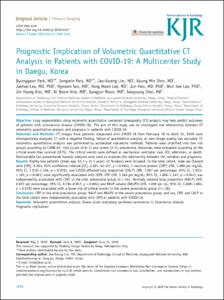Prognostic Implication of Volumetric Quantitative CT Analysis in Patients with COVID-19: A Multicenter Study in Daegu, Korea
- Affiliated Author(s)
- 김진영
- Alternative Author(s)
- Kim, Jin Young
- Journal Title
- Korean Journal of Radiology
- ISSN
- 2005-8330
- Issued Date
- 2020
- Keyword
- Volumetric quantitative analysis; Severe acute respiratory syndrome coronavirus 2; Coronavirus disease; Prognostic implication
- Abstract
- Objective:
Lung segmentation using volumetric quantitative computed tomography (CT) analysis may help predict outcomes of patients with coronavirus disease (COVID-19). The aim of this study was to investigate the relationship between CT volumetric quantitative analysis and prognosis in patients with COVID-19.
Materials and Methods:
CT images from patients diagnosed with COVID-19 from February 18 to April 15, 2020 were retrospectively analyzed. CT with a negative finding, failure of quantitative analysis, or poor image quality was excluded. CT volumetric quantitative analysis was performed by automated volumetric methods. Patients were stratified into two risk groups according to CURB-65: mild (score of 0–1) and severe (2–5) pneumonia. Outcomes were evaluated according to the critical event-free survival (CEFS). The critical events were defined as mechanical ventilator care, ICU admission, or death. Multivariable Cox proportional hazards analyses were used to evaluate the relationship between the variables and prognosis.
Results:
Eighty-two patients (mean age, 63.1 ± 14.5 years; 42 females) were included. In the total cohort, male sex (hazard ratio [HR], 9.264; 95% confidence interval [CI], 2.021–42.457; p = 0.004), C-reactive protein (CRP) (HR, 1.080 per mg/dL; 95% CI, 1.010–1.156; p = 0.025), and COVID-affected lung proportion (CALP) (HR, 1.067 per percentage; 95% CI, 1.033–1.101; p < 0.001) were significantly associated with CEFS. CRP (HR, 1.164 per mg/dL; 95% CI, 1.006–1.347; p = 0.041) was independently associated with CEFS in the mild pneumonia group (n = 54). Normally aerated lung proportion (NALP) (HR, 0.872 per percentage; 95% CI, 0.794–0.957; p = 0.004) and NALP volume (NALPV) (HR, 1.002 per mL; 95% CI, 1.000–1.004; p = 0.019) were associated with a lower risk of critical events in the severe pneumonia group (n = 28).
Conclusion:
CRP in the mild pneumonia group; NALP and NALPV in the severe pneumonia group; and sex, CRP, and CALP in the total cohort were independently associated with CEFS in patients with COVID-19.
- Department
- Dept. of Radiology (영상의학)
- Publisher
- School of Medicine (의과대학)
- Citation
- Byunggeon Park et al. (2020). Prognostic Implication of Volumetric Quantitative CT Analysis in Patients with COVID-19: A Multicenter Study in Daegu, Korea. Korean Journal of Radiology, 21(11), 1256–1264. doi: 10.3348/kjr.2020.0567
- Type
- Article
- ISSN
- 2005-8330
- Appears in Collections:
- 1. School of Medicine (의과대학) > Dept. of Radiology (영상의학)
- 파일 목록
-
-
Download
 oak-2020-0664.pdf
기타 데이터 / 1.9 MB / Adobe PDF
oak-2020-0664.pdf
기타 데이터 / 1.9 MB / Adobe PDF
-
Items in Repository are protected by copyright, with all rights reserved, unless otherwise indicated.